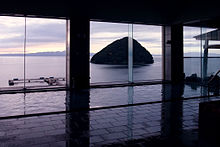
Back أونسن Arabic Onsen Azerbaijani Onsen Catalan Onsen Czech Onsen Danish Onsen German Όνσεν Greek Onsen Esperanto Onsen Spanish Onsen Estonian

In Japan, onsen (温泉) are hot springs and the bathing facilities and traditional inns around them. There are approximately 25,000 hot spring sources throughout Japan, and approximately 3,000 onsen establishments use naturally hot water from these geothermally heated springs.[1]
Onsen may be either outdoor baths (露天風呂 or 野天風呂, roten-buro / noten-buro) or indoor baths (内湯, uchiyu). Traditionally, onsen were located outdoors, although many inns have now built indoor bathing facilities as well. Nowadays, as most households have their baths, the number of traditional public baths has decreased,[2] but the number and popularity of hot spring resort towns (温泉街, onsen-gai) have increased since the end of Second World War.[3] Baths may be either publicly run by a municipality or privately, often connecting to a lodging establishment such as a hotel, ryokan, or minshuku.

The presence of an onsen is often indicated on signs and maps by the symbol ♨, the kanji 湯 (yu, meaning "hot water"), or the simpler phonetic hiragana character ゆ (yu).
- ^ Erikson, August; Masui, Anette (2014). Sacred Waters: A Guide to Japanese Hot Springs. Karlstad, Sweden: Votum Forlag AB. p. 88. ISBN 978-91-87283-33-8.
- ^ "Public Baths in Japan". www.japan-guide.com. Retrieved 17 October 2018.
- ^ "温泉の歴史(現代)※第二次世界大戦後 | 日本温泉協会". 一般社団法人 日本温泉協会 ~温泉名人~ (in Japanese). Retrieved 25 July 2024.
© MMXXIII Rich X Search. We shall prevail. All rights reserved. Rich X Search